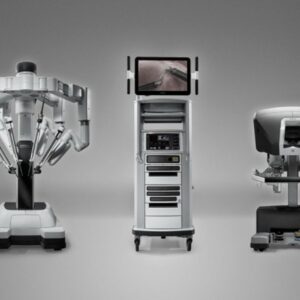
Robotic surgery is an important technological innovation in the field of medicine, which comes to evolve and go beyond laparoscopy.
It is a minimally invasive surgical technique that allows the performance of complex operations, through incisions in the skin that are less than 1 cm. Robotic systems are used exclusively by highly specialized surgeons and allow complex abdominal surgeries to be performed with great safety.
Robotic surgery finds application in many medical specialties such as gynaecology, general surgery and urology. In particular, there are diseases in which robotic surgery is the only minimally invasive technique that can be applied and this fact proves the safety and effectiveness of these operations. In the case of gynaecological surgeries, robotic techniques are used to maintain and restore fertility but also for gynaecological cancer.
Robotic surgery: the modern laparoscopy
Robotic surgery retains all  the advantages of traditional laparoscopy and in addition ensures minimal postoperative pain, very little blood loss and a lower rate of surgical complications. The vast majority of surgeries require 3 or 4 incisions of 8 mm and one night in the hospital. The patient returns home the next day from the surgery with the appropriate treatment.
the advantages of traditional laparoscopy and in addition ensures minimal postoperative pain, very little blood loss and a lower rate of surgical complications. The vast majority of surgeries require 3 or 4 incisions of 8 mm and one night in the hospital. The patient returns home the next day from the surgery with the appropriate treatment.
The DaVinci robotic system was first approved by the FDA in 2005 and has since helped surgeons achieve better and safer surgical results. Robotic surgeries allow 3D vision, complete freedom of movement of surgical instruments, while reducing the surgeon’s physical fatigue and allow operations with very low intra-abdominal pressures, thus limiting the anaesthesia complications. What is more, robotic surgeries are the ideal method for patients with increased body weight, who until now could not be operated with traditional laparoscopy.
During the pandemic, the first concern is the health of patients and hospital staff. Robotic gynaecological surgeries continue to be performed after ensuring that all the international safety protocols are faithfully followed.
The Society of European Robotic Gynaecological Surgery (SERGS) declared that “… a great advantage of using a robotic platform is the fact that in times of extreme shortage of hospital beds hospital stay can be minimized also for urgent patients that need (radical) complex procedures that might not or less be feasible with conventional laparoscopy. In conclusion, RAS may help in minimizing the risk for contamination of healthcare providers and to make optimal use of residual resources”.
The following table depicts a risk comparison of robot assisted, conventional laparoscopic and open surgery under COVID-19 circumstances.

